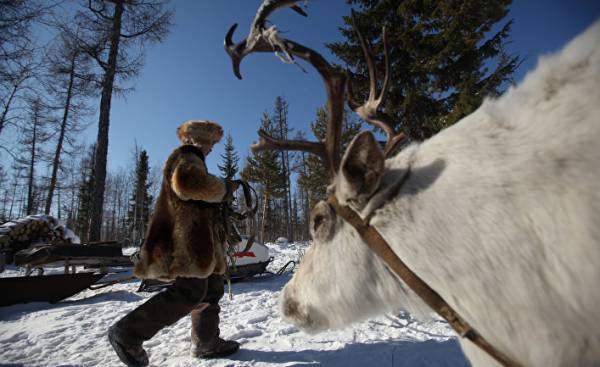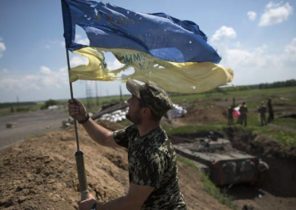
For two days and two nights I am a passenger coming from Moscow train. We pass the station Sob’, we cross the Arctic circle and move further in the direction of Salekhard, the administrative centre of the Yamalo-Nenets Autonomous district. There I Board a six-wheeled vehicle. We are on the ice crossing the mouth of the river Obi here in the far North, no bridges and heading North in the direction of the Yamal Peninsula. In this area a lot of oil and natural gas on the Yamal Peninsula resembles a finger pointing to the North pole.
The purpose of my trip — the camp of the local Nenets reindeer herders in the Arctic tundra, located in the place where the years of the Ural, separating Europe from Asia, crossing the plains, blown by powerful winds. This Russian version of the adventure tourism — this possibility is only beginning to emerge in such a remote area — has a certain style. We move in the vehicle “Trekol” Russian production, which would fit perfectly for the polar version of “Mad max”. This SUV tubeless low pressure, and it has amphibious qualities (required in case if the ice on the river will fail). Once it so happened in the course of our trip, when we, after breaking the ice, was on the surface of a slowly flowing river. At the time I thought we fell on some soft cloud. I’m glad “Trekol” has such capabilities. If you happen to have something emergency, rescuers will not be easy to get here and help you. So here, in the snow on the side of the only road you can see a lot of iron cores — backhoes, all sorts of trucks.
The terrain becomes more desolate as you move further North, and finally, we’re moving the knurled road and start to walk in the snow. During the first few hours of the trip around the “Trekol” arise the whirling snow. It seems as if you are in the center of the ping-pong table. Then the weather changes and the sun becomes a pale disk in the glow of ice crystals. The sky is gray-blue. Even swampy soil looks adorable — it’s covered in silver frost and large patches of frozen cobalt.
We stop for a while in order to feel the peace. It is a silent space deep and wide. I hear the tinkling branches in the icy wind. We see the Fox sneaking through the bare tundra, and the traces of ptarmigan look like stars. When I clap, a small flock of these birds rising into the air like sparks of fireworks.
For some time we do not meet on the way, and then suddenly appears before us the purpose of our trip. It’s located in the tundra on a small hill Church its outline resembles the castles from the movies of the Studio “Disney.” Around it there are seven chapels, several small houses and a tent — that is a traditional teepee nomads, where I will spend the next four nights. There’s another lake, I say. But it’s hard to determine where it begins and where it ends, but it is here as a hidden moat behind the Golden crosses of the wooden Church. This camp, dubbed “Land of hope”, is located about 25 kilometers from the nearest settlement of Laborovaya trading post. Here Anna Pavlovna of Nerkagi — she is a Russian writer and educator, directs the work of the orphanage and school for local herders, or the Nenets are representatives of the indigenous population, which belongs to herself.
Anna Pavlovna is a strange mixture. She quotes “don Quixote”, Goethe and Byron. Her severe manner, however, it is a mesmerizing effect on the audience around her Nenets children — as the hero of a tale, playing the flute. She is an active proponent of maintaining the traditional lifestyle of his people — she’s very small, not above my shoulder, and a devout Christian, and it is her job to attract to the fold of Christianity new members were led in 2010 to the construction of the local Church. “Have you ever heard of Armageddon?— she asks, and adds — This place will survive.” Her remark caught me off guard.
When I first heard about this unusual trip to the Yamal Peninsula, located in the Melbourne tourist company “Intrepid Travel”, nobody talked about God. I think that you will hear the sounds of the shamanic drum and not talk about the saints. This was my own ignorance of the exotic, because it turned out that I fell behind by a century and maybe more. The king sent the missionaries. When Stalin built all of the Nenets on the line, it is, in fact, erased from the face of the shamanism of Siberia, from lake Baikal to the Bering Strait. Nenets reindeer herds were collectivized, and their children sent to boarding schools, where teaching is largely conducted in Russian, and not in the local language. But in 1947, Stalin wanted to access the rich natural resources of this region, or at least he tried to lay the foundations to the far North began to generate income. He proposed the idea of building a railway connecting Salekhard with Igarka — a town located about 1200 miles East along the Arctic circle. By the time of Stalin’s death in 1953, killed many thousands of prisoners worked on its construction, and therefore it was called “Dead road”. When Stalin died, it was built only 700 kilometres of railway track, and then further construction was abandoned. However, despite the setback with construction of a new branch, mining industry since that time, thrive in this region. In the 1970-ies in Salekhard appeared roads with asphalt coating, and today the population is about 45 thousand people.
Like other native residents in the area from the Congo to Canada, the Nenets are trying to find their place in this complicated and rapidly modernized world. The territory, through which roamed their ancestors, affected the process of development, but they also benefit from education and resources related to well-being. I see this tension in the figure made by the child in the Nenets boarding school, which I visited in Salekhard and now teaching in the local language. It depicts a reindeer herder, oil tanker, pipe, and a polar bear on an iceberg.
Some of the Nenets people believe that the tundra is too harsh climate, and leave these places, while appearing from time to time, anthrax is capable of one season destroy all their herds. Other Nenets transition from nomadic life to the city ends with the alcoholic chaos. Modern Russia is a Nenets opportunities for a successful city career, but activities Pavlovna provides an alternative option. It provides shelter, safety and education of approximately 45 herders, including six orphans, all of them unable to have her traditional knowledge. This is the world that p. gradually opens for tourist visits in the hope that its initiative will help her to create in the tundra small company — and possibly more of the Nenets will remain in their homes. Her first paid guests arrived at the beginning of this year, and she had optimism, though moderate. “The word “hope” has the same base and the weight in the Nenets language,” she says.
Pavlovna, of course, makes no compromises to outsiders, although the challenges become more serious in the winter (my visit took place in March) and warm summer in the tundra the gnats and this problem should not be underestimated. Visitors are allowed to explore, but they can’t change the way of life of the Nenets and ask them for more than they can give. There’s no comfort except the bathing place — the Russian Banya, which is run by a former alcoholic, which p. took under his wing. In the morning there is no fresh coffee and this is the simple difference in our cultures, however, it appeared to accept that it was difficult for me. Instead, each day began with a discussion of temperature, and the thermometer ranged from 20 minutes up to minus 40. We build the fire in the stove and reluctantly crawl out from under several layers of twigs of spruce, smelling of wood and smoke. A piece of ice melted in order to make tea. Oil hardened from the cold. We eat it with pieces along with candied berries on thick slices of bread.
P. acts as guide and helps her duck and her brother Ivan Pavlovich of Nerkagi. Pavlovna couple adopted children more than 30 to cook us a meal consisting of raw or pickled fish and reindeer meat. One of her older nephews manages the snowmobile attached to a long sled. After many conducted in this trailer hours, I find the soothing sound of the sledge moving over the icy crust. We are trying to catch grayling, through the work done in the ice hole. Our rod is a part of a slotted spoon. “Trekol” we’re going to Gornoaltaisky natural reserve, where we meet a herd of musk oxen. And after 40 kilometers, we help to catch deer and drinking tea in another tent in our honour owners get English tea set Lefard, which, apparently, is the only modern thing (they have satellite). In winter, the family moved five or six times, and then selects the place for a summer calving.
Back at camp, I am immersed in the life of this community — in school, hanging around in the kitchen, watching, as engaged in embroidery Nenets girls. “I don’t want our tradition was gone with the wind,” says Anna Andreyevna Laplander, Nenets, adopted by p. at the age of 11 years (at that time her father died of tuberculosis, and her mother was no longer able to cope). “We want the next generation to continue our work and survived with his help,” she adds. Anna Andreevna is a teacher now and calls the city “the cage”. “Tundra is my choice,” she says.
First, I like this region for aesthetic reasons. There is some internal elegance in the lives of the Nenets, from the ballet spirals lasso, with which they catch deer, to narrow the trunk of the mountain ash, which they use to control the herd. Nenets children wear cloaks with hoods, which turn their heads in the fluffy fur of a circle. Men wear thin, and tall boots, tied with colorful ribbons with beads, while the women wear richly embroidered coats of reindeer skins, down just below the knee. As for Pavlovic, that old man from the tundra, it sometimes looks like a character from the book “the Hobbit” — in his cassock with a leather belt hung with knives and pouch of tobacco. He’s very short in stature, he had a crooked smile, and his proof was violated only one time during our trip, and it happened under the influence of the sound of falling snow. Recently, the avalanche has covered all his herd, he says. It tells the story of Siirt — indigenous people, representatives of which the Nenets were forced out of this land and forced to live in the dungeon. “They are short in stature?” — I ask. “Very little,’ he replies. — Much less me.” And when they were last seen, I ask. “Better ask about it to Anna Pavlovna, he says. — My main job is fishing and deer”.
P. shows me a rocky hill, which, according to her, serves as the entrance to the tent Siirt. She calls them trolls, mysterious people, hiding their treasures. I ask her how the story Siirt get along with her, along with the Christian faith? These sacred hills are the unfinished altars and churches, she says.
Her brother leads us to a steep cliff at the beginning of a great and elevated valleys. I gaze into it’s depth on top of conifer trees decorated with snow balls. “I’ve been on the edge of the world — said Pavlovich, describing his journey North to the Kara sea, washing the tip of the Yamal Peninsula. — But in Moscow I was not”. In the evening I hear he calls the European part of Russia “the mainland”. The Yamal Peninsula is not an island, but its insularity probably allows you to say so.
The silence is full, and it is broken only by the crackling of broken ice or birds in the sky. Here such beauty, such mystery, that not even Stalin could destroy it trying to clean Siberia from shamanism. The tundra shines in a pink twilight. I hear the sound of Church bells and the sound of footsteps is people rush to evening service. But I’m not joining him, and going alone to the edge of the camp. All are covered with snow like a white blanket. Come across small hills is hunched dog. The whole tundra is covered with ice, its tall grass decorated with frost. I look at the sunset, and a torn cloud becomes silver in the moonlight. Here distant constellations seem closer than home, and the extent of Arctic freaks me out beyond myself and the society to which I belong, what makes me different to think about who is who.







